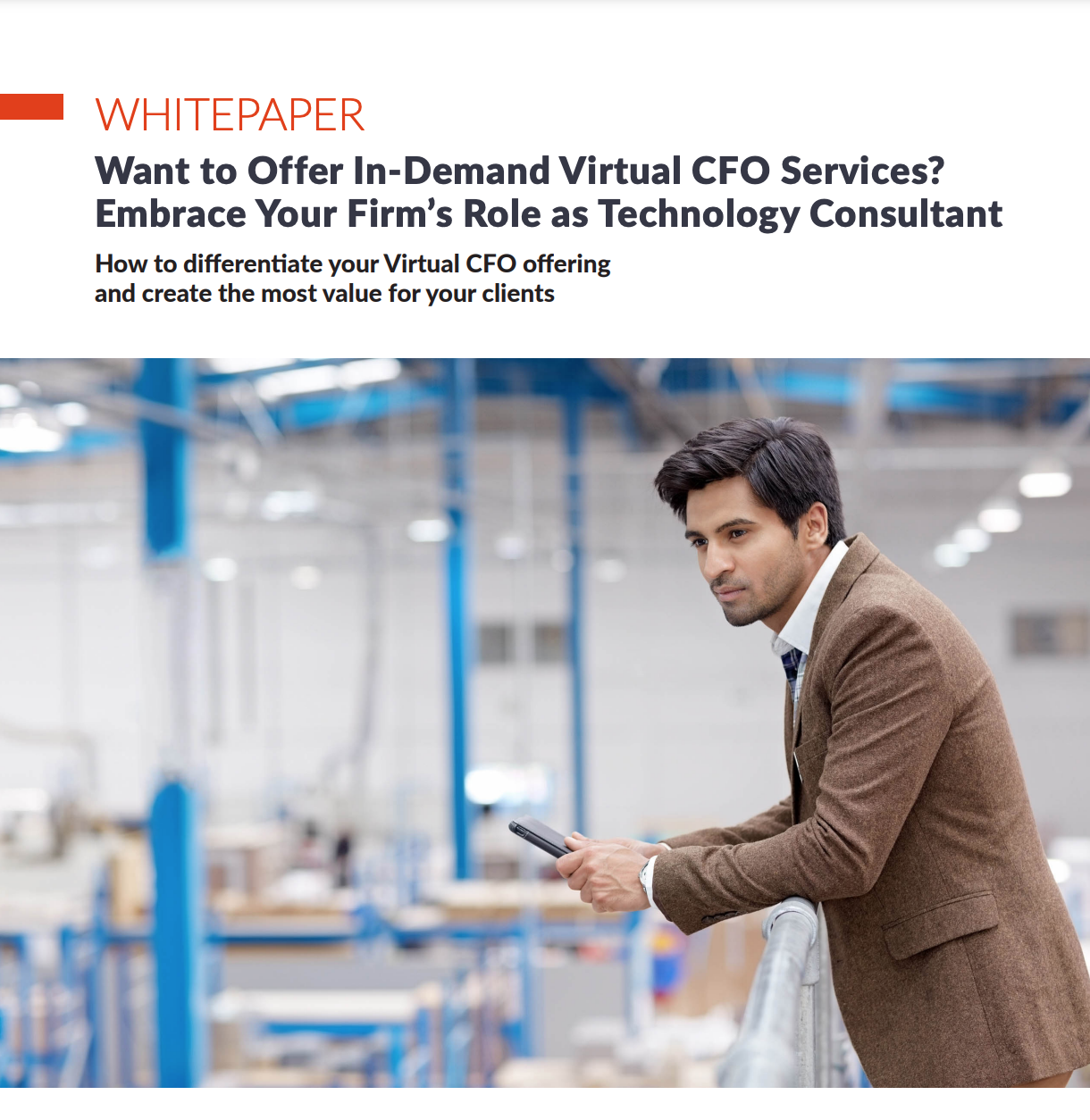How to Offer Virtual CFO Services Using Cloud-Based Accounting Practice Management Software

If your clients have the tools available to comfortably enter financial transactions, run reports, and even prepare their business taxes, how do you grow your firm? By learning how to become a virtual CFO and offering value added accounting services.
How to grow your accounting practice when revenue streams are hard to find
Increased competition and reduced need for ancillary services have left some accounting firms struggling to increase revenue. User friendly accounting firm technologies have made it easier than ever for small to midsize businesses to adequately manage their finances, while easy to use payroll services have nearly eliminated the need for accounting firms to offer payroll to clients. Meanwhile, the ready availability of tax preparation software for small businesses has increased the number of business owners comfortable preparing their own taxes.
Today, small business owners don’t need a CPA to post transactions, run financial statements, or pay their employees. They need a partner that can strategically guide their business from startup to success; a seasoned professional to help them make high-level decisions. They need an advisor, not a bookkeeper.
They need an outsourced (virtual) CFO.
 Download our free guide Want to Offer In-Demand Virtual CFO Services? Embrace Your Firm’s Role as Technology Consultant to learn how to create the most value for your clients, and differentiate your virtual CFO offering from your competitors
Download our free guide Want to Offer In-Demand Virtual CFO Services? Embrace Your Firm’s Role as Technology Consultant to learn how to create the most value for your clients, and differentiate your virtual CFO offering from your competitors
What is a virtual CFO?
Large and small businesses alike would benefit from having a CFO on staff. Unfortunately, most small businesses have limited funds available to hire a full time CFO. That’s where the virtual CFO comes into play. With new businesses being created in record numbers, there’s never been a better time for your firm to offer virtual outsourced CFO services.
Virtual CFOs work with businesses, providing them with the financial guidance and support that they need, at a fraction of the cost of bringing on a full time CFO. And smaller businesses are more likely to use outsourced CFO services than to pay a full time employee.
Impossible twenty years ago, the ready availability of cloud-based accounting software, video conferencing tools, and instant messaging apps have made it easy to offer virtual CFO services to new and existing clients. Instead of concentrating on tax preparation, you’ll also be managing bookkeeping staff, creating cash forecasts, and assisting in the creation of a strategic plan for your clients, working less in a service role and more as an advisor.
According to William Hill, product manager with the Tax Professionals segment of Thomson Reuters, accounting firms need to evolve in order to thrive.
“Be a business advisor who provides high-value consultative services in addition to tax and accounting work. This is viable because, frankly, you already do it,” says Hill.
How to become a virtual CFO
Outsourced virtual CFO services can vary from firm to firm, with most offering a variation of the following:
- Oversight of day to day bookkeeping and accounting activities
- Financial reporting and analysis
- Cash management
- Budgeting
- Strategic planning and oversight
This model leaves the door wide open for firms to design value added accounting services packages designed for broad and niche industries.
Decide on the CFO services your firm will offer
The first step to offering virtual CFO services is to determine what you’re comfortable offering. For example, if you’re offering outsourced CFO services to smaller businesses, you might include: monthly oversight, cash flow management, and financial reporting, with expanded offerings like budgeting and forecasting, and strategic planning. Of course, larger businesses can benefit from additional services such as debt management, financial ratios, and capital investment planning and management.
Establish how to price your value added accounting services
A good start is to create a menu of services available, with pricing increasing for each level of service provided. Start with the basics, and make those services affordable for even the smallest business, while also offering an expanded level of services that are better suited to growing and more established businesses. Make it clear that these are value added accounting services — and are therefore much more hands-on than simply preparing financial statements for your clients. Instead, you will be providing high-level financial insight for their business, a much different set of services that involves much more hands-on delivery.
Market / upsell your services
While many of your current clients will likely continue to subscribe to standard accounting services, it’s important that your clients are made aware of the value added services you offer as well. For example, if you currently complete a tax return for a small business, why not advise them of the advantages of utilizing your virtual CFO services as well. And by offering a flexible pricing structure, such as value pricing, it’s much easier for a client to start slow, and add additional services when they’re ready.
Ensure you’ve got the underlying technology
Prior to going live with virtual CFO services, it’s important that you determine what applications you’re comfortable using in your practice. If your firm is already using cloud technology, then you’re well on your way. If not, it’s time to start exploring the numerous options that are available to your firm and your clients. It can work to your advantage to suggest your clients use the same software application that your firm uses, making it easier to access and share data. However, the only real requirement is that your client use cloud technology that allows you to log into the system and view their data.
Making the case: What are the advantages of a virtual CFO for small businesses?
Using a virtual CFO allows your clients to streamline costs by having a clerk handle data entry and routine bookkeeping, while the virtual CFO (you) is available to deal with more complex financial issues such as creating accurate cash projections, controlling spending, and providing professional feedback on important business decisions; all tasks which are commonly outside the business owner’s comfort zone.
When meeting with a client for the first time, be sure to advise them that your firm is able to provide more in-depth services than simply managing their transactions and running financial statements. For starters, if your client wants you to run financial statements, explain to them that while you’d be happy to run reports, it’s more important to understand what the numbers are on the reports than it is to simply run one.
“Transitioning your practice to an advisory services model requires you to shift your perspective,” says William Hill.
That includes offering customers advisory services that are designed to address the future, not just account for the past. And while financial accounting focuses on the past, turning their attention to the future can be much more advantageous.
Offering virtual CFO services is easier than ever before. Available technology provides a more hands-on future for your firm and your clients, and can benefit both your client and your firm. Isn’t it time to start taking advantage of it today?
For more information download our free guide Want to Offer In-Demand Virtual CFO Services? Embrace Your Firm’s Role as Technology Consultant today!